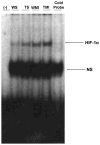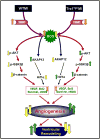Thioredoxin 1 enhances neovascularization and reduces ventricular remodeling during chronic myocardial infarction: a study using thioredoxin 1 transgenic mice
- PMID: 21074540
- PMCID: PMC3397477
- DOI: 10.1016/j.yjmcc.2010.11.002
Thioredoxin 1 enhances neovascularization and reduces ventricular remodeling during chronic myocardial infarction: a study using thioredoxin 1 transgenic mice
Abstract
Oxidative stress plays a crucial role in disruption of neovascularization by alterations in thioredoxin 1 (Trx1) expression and its interaction with other proteins after myocardial infarction (MI). We previously showed that Trx1 has angiogenic properties, but the possible therapeutic significance of overexpressing Trx1 in chronic MI has not been elucidated. Therefore, we explored the angiogenic and cardioprotective potential of Trx1 in an in vivo MI model using transgenic mice overexpressing Trx1. Wild-type (W) and Trx1 transgenic (Trx1(Tg/+)) mice were randomized into W sham (WS), Trx1(Tg/+) sham (TS), WMI, and TMI. MI was induced by permanent occlusion of LAD coronary artery. Hearts from mice overexpressing Trx1 exhibited reduced fibrosis and oxidative stress and attenuated cardiomyocyte apoptosis along with increased vessel formation compared to WMI. We found significant inhibition of Trx1 regulating proteins, TXNIP and AKAP 12, and increased p-Akt, p-eNOS, p-GSK-3β, HIF-1α, β-catenin, VEGF, Bcl-2, and survivin expression in TMI compared to WMI. Echocardiography performed 30days after MI revealed significant improvement in myocardial functions in TMI compared to WMI. Our study identifies a potential role for Trx1 overexpression and its association with its regulatory proteins TXNIP, AKAP12, and subsequent activation of Akt/GSK-3β/β-catenin/HIF-1α-mediated VEGF and eNOS expression in inducing angiogenesis and reduced ventricular remodeling. Hence, Trx1 and other proteins identified in our study may prove to be potential therapeutic targets in the treatment of ischemic heart disease.
Copyright © 2010 Elsevier Ltd. All rights reserved.
Figures








Similar articles
-
Glutaredoxin-1 overexpression enhances neovascularization and diminishes ventricular remodeling in chronic myocardial infarction.PLoS One. 2012;7(3):e34790. doi: 10.1371/journal.pone.0034790. Epub 2012 Apr 16. PLoS One. 2012. PMID: 22523530 Free PMC article.
-
Thioredoxin-1 gene therapy enhances angiogenic signaling and reduces ventricular remodeling in infarcted myocardium of diabetic rats.Circulation. 2010 Mar 16;121(10):1244-55. doi: 10.1161/CIRCULATIONAHA.109.872481. Epub 2010 Mar 1. Circulation. 2010. PMID: 20194885 Free PMC article.
-
Thioredoxin-1 (Trx1) engineered mesenchymal stem cell therapy increased pro-angiogenic factors, reduced fibrosis and improved heart function in the infarcted rat myocardium.Int J Cardiol. 2015 Dec 15;201:517-28. doi: 10.1016/j.ijcard.2015.08.117. Epub 2015 Aug 15. Int J Cardiol. 2015. PMID: 26322599
-
Thioredoxin regulation of ischemic preconditioning.Antioxid Redox Signal. 2004 Apr;6(2):405-12. doi: 10.1089/152308604322899477. Antioxid Redox Signal. 2004. PMID: 15025942 Review.
-
Application of recombinant thioredoxin1 for treatment of heart disease.J Mol Cell Cardiol. 2011 Oct;51(4):570-3. doi: 10.1016/j.yjmcc.2010.09.020. Epub 2010 Oct 16. J Mol Cell Cardiol. 2011. PMID: 20955713 Free PMC article. Review.
Cited by
-
Energy restriction induced SIRT6 inhibits microglia activation and promotes angiogenesis in cerebral ischemia via transcriptional inhibition of TXNIP.Cell Death Dis. 2022 May 11;13(5):449. doi: 10.1038/s41419-022-04866-x. Cell Death Dis. 2022. PMID: 35562171 Free PMC article.
-
Dynamic Regulation of Cysteine Oxidation and Phosphorylation in Myocardial Ischemia-Reperfusion Injury.Cells. 2021 Sep 11;10(9):2388. doi: 10.3390/cells10092388. Cells. 2021. PMID: 34572037 Free PMC article. Review.
-
Protective effects of Phyllanthus emblica against myocardial ischemia-reperfusion injury: the role of PI3-kinase/glycogen synthase kinase 3β/β-catenin pathway.J Physiol Biochem. 2015 Dec;71(4):623-33. doi: 10.1007/s13105-015-0426-8. Epub 2015 Sep 5. J Physiol Biochem. 2015. PMID: 26342597
-
Cardiovascular redox and ox stress proteomics.Antioxid Redox Signal. 2012 Dec 1;17(11):1528-59. doi: 10.1089/ars.2012.4706. Epub 2012 Aug 10. Antioxid Redox Signal. 2012. PMID: 22607061 Free PMC article. Review.
-
Physiologic and pathophysiologic roles of AKAP12.Sci Prog. 2022 Jul-Sep;105(3):368504221109212. doi: 10.1177/00368504221109212. Sci Prog. 2022. PMID: 35775596 Free PMC article.
References
-
- Molin D, Post MJ. Therapeutic angiogenesis in the heart: protect and serve. Curr Opin Pharmacol. 2007;7:158–63. - PubMed
-
- Losordo DW, Dimmeler S. Therapeutic angiogenesis and vasculogenesis for ischemic disease. Part I: angiogenic cytokines. Circulation. 2004;109:2487–91. - PubMed
-
- Billiet L, Rouis M. Thioredoxin-1 is a novel and attractive therapeutic approach for various diseases including cardiovascular disorders. Cardiovasc Hematol Disord Drug Targets. 2008;8:293–6. - PubMed
Publication types
MeSH terms
Substances
Grants and funding
LinkOut - more resources
Full Text Sources
Medical
Molecular Biology Databases
Miscellaneous

